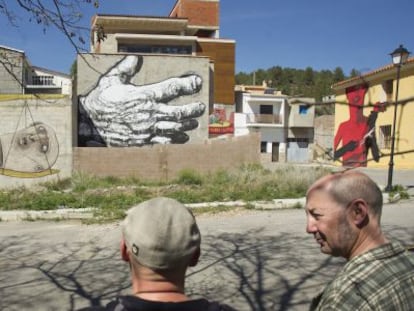How the Spanish Banksy used Picasso in unique protest against bullfighting
Sam3 has impressed Santa Pola town hall in Alicante with ingenious Guernica reproduction
On May 18, one of Spain’s roadside Osborne bulls was used as a gigantic 14-meter-high canvas for a reproduction of Picasso’s famous anti-war mural Guernica. This powerful urban masterpiece in the Mediterranean resort town of Santa Pola, in Alicante province, was the work of Sam3, a street artist from Murcia whose signature is recognized around the world thanks, among other things, to social media.
Now, after some deliberation, city officials in Santa Pola have backed the transformation of the otherwise all-black icon. But they note that the Osborne company has the last word as to whether the bull is repainted or not, as it has image rights over what used to be a roadside billboard advertising brandy, but has since become a popular symbol of Spain.
El monstruo de la guerra fue retratado en 1937 y Guernica es sólo uno de sus nombres, le gusta pastar donde hay inocentes y desarmados. Tauromaquia de cobardes. Reverencia a #picasso
Posted by Sam3 on Thursday, May 18, 2017
The Sam3 bull in Santa Pola: "The monster of war was portrayed in 1937 [by Picasso] and Guernica is only one of its names, it likes to prey on the innocent and unarmed. Bullfighting is for cowards. Respect to Picasso"
“Guernica is war and all that it implies: horror, abuse, devastation, death, victims, spectacle,” explains Sam3, who has collaborated with the British urban artist Banksy, and whose art can be seen around the world.
Sam3 relates all these concepts to bullfighting, a tradition he criticizes, though he appreciates the iconic nature of the Osborne bull. It is, he says, a symbol, and it makes a useful canvas.
The Osborne bull is a gigantic monster akin to Don Quixote’s windmills. It watches us closely, but also turns its back on us Sam3
In fact, the street artist has a very particular take on the Osborne bull. “It is a gigantic monster akin to Don Quixote’s windmills,” he says. “It watches us closely, but also turns its back on us. It represents something very irrational and characterizes the spirit of the Mediterranean people.”
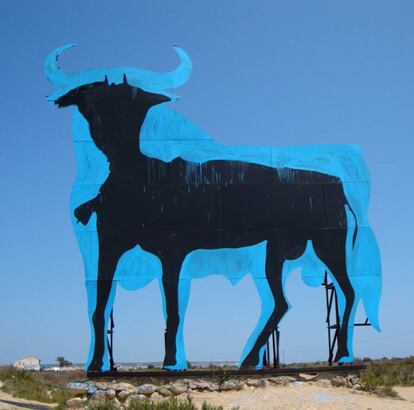
“Can we class art as vandalism?” muses Mercedes Landa, who is in charge of tourism at this popular summer resort. “When I look at the bull now, I see art, but also a cry for freedom and a cry against war. Everyone in Santa Pola is talking about our very own Guernica, though it’s not the municipality’s decision whether or not the bull should go back to black. That is a decision for the Osborne group, as they are the ones who pay for its maintenance. Anyway,” she adds, “we're going to send a letter to the company to see if there is a chance of keeping it.”
When I look at the bull now, I see art, but also a cry for freedom and a cry against war Mercedes Landa, tourism chief Santa Pola
According to Landa, the bull has had its ups and downs in this particular part of Spain. “Once his testicles were yanked off,” she explains. “And not long ago, there was a storm that toppled it. It has also been painted several times before.”
One of the occasions Landa is referring to was in 2009, when Sam3 superimposed a painting of a lean heifer on the bull as an allusion to the economic crisis. On that occasion, the town hall did want the painting scrubbed off. “Although the message was opportune, it ridiculed the figure of the bull,” Landa says.
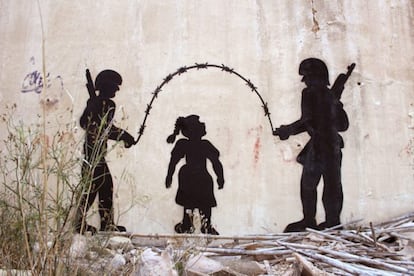
The Guernica bull carries with it an implicit anti-bullfighting message, which appears to be acceptable to the town hall. “It has become the most original Osborne bull in Spain,” says Landa, who has clocked its tourism potential. “Given the artist’s fame and the controversy surrounding it, the best thing would be to tell people a bit about Sam3. It has already attracted quite a few visitors wanting to be have their photograph taken with it.”
There is also an Osborne bull in the Madrid region that bears the Sam3 signature. This one has a skeleton painted on it, in another reference to the economic and social crisis in Spain.
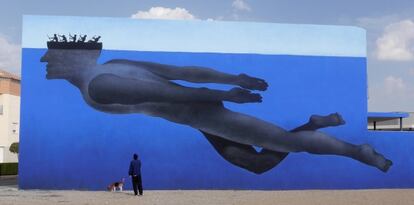
When queried about the Guernica reference on the Santa Pola bull and the town hall’s request to keep it, an Osborne spokesman told EL PAÍS that “the Osborne group is evaluating how to proceed to restore and recover the integrity of the bull located close to the Salinas Natural Park in Santa Pola.”
Who is Sam3?
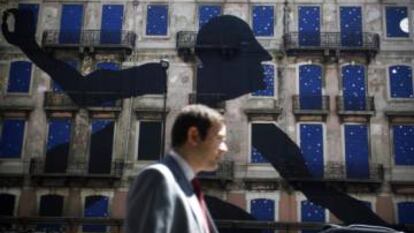
Little is known about Sam3, except that he was born in Elche in 1980 and grew up in Murcia. But while the artist prefers to remain largely anonymous, his work can be seen on buildings and walls in Athens, Quito, Lisbon, Atlanta, Paris and in many Spanish cities, including Murcia, Madrid and Barcelona.
An artist who uses the streets as his gallery, Sam3 believes that drawing is a “daily exorcism.” There is also a political element to his work, though he prefers not to make too much of this. “Just painting in a public space is a political statement,” he says. “Politics is nothing more than the stuff that affects us all.”
At times ironic and at others poetic, he is one of the greatest urban artists of our time and was the only Spanish artist to collaborate with British street artist Banksy’s ambitious Bethlehem project, Santa’s Ghetto, which decorated the wall dividing Israel from Palestine in the West Bank city of Bethlehem on Christmas Eve 2007.
Sam3 considers himself to be a novice on social networks, which are, he says, “a double-edged sword.” However, photos of his art have been shared by his followers on photography platforms such as Flickr for the past 10 years.
English version by Heather Galloway.
Tu suscripción se está usando en otro dispositivo
¿Quieres añadir otro usuario a tu suscripción?
Si continúas leyendo en este dispositivo, no se podrá leer en el otro.
FlechaTu suscripción se está usando en otro dispositivo y solo puedes acceder a EL PAÍS desde un dispositivo a la vez.
Si quieres compartir tu cuenta, cambia tu suscripción a la modalidad Premium, así podrás añadir otro usuario. Cada uno accederá con su propia cuenta de email, lo que os permitirá personalizar vuestra experiencia en EL PAÍS.
¿Tienes una suscripción de empresa? Accede aquí para contratar más cuentas.
En el caso de no saber quién está usando tu cuenta, te recomendamos cambiar tu contraseña aquí.
Si decides continuar compartiendo tu cuenta, este mensaje se mostrará en tu dispositivo y en el de la otra persona que está usando tu cuenta de forma indefinida, afectando a tu experiencia de lectura. Puedes consultar aquí los términos y condiciones de la suscripción digital.
More information
Archived In
Últimas noticias
Most viewed
- Pablo Escobar’s hippos: A serious environmental problem, 40 years on
- Why we lost the habit of sleeping in two segments and how that changed our sense of time
- Charles Dubouloz, mountaineering star, retires at 36 with a farewell tour inspired by Walter Bonatti
- Reinhard Genzel, Nobel laureate in physics: ‘One-minute videos will never give you the truth’
- The Florida Keys tourist paradise is besieged by immigration agents: ‘We’ve never seen anything like this’
